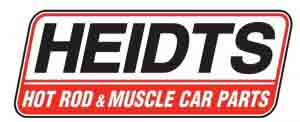
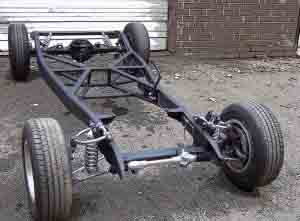
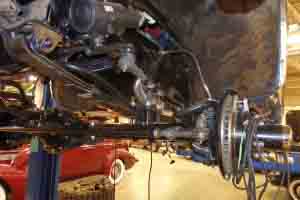
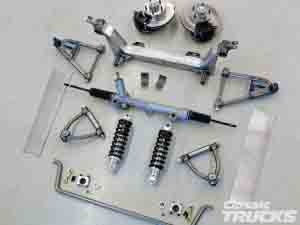
Control arms, Coil Springs, sway bar, leaf springs, bushings ARRGGHHHHHHHHH!!! It’s just too much. Well let’s try and make sense of these terms and see just what these components do.
The Brush “Runabout”
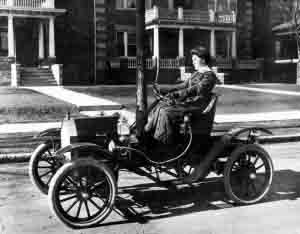
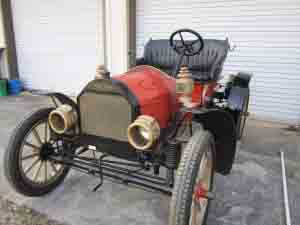
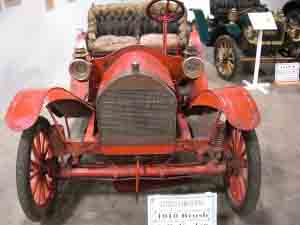
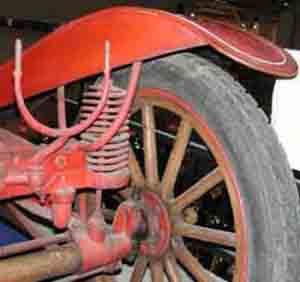
Alanson Brush and his “Brush Runabout” are credited with the first mass produced vehicle with a shock absorber. You may see little importance to this small hydraulic miracle, many car owners still don’t understand what importance a shock absorber has in controlling their ride, improving overall handling and improving brake effectiveness. You see, springs have been around for ages, leaf springs can be traced to the Egyptians and Siege machines used in Europe. Coil springs have also been widely used and, along with leaf springs, heavily used with auto manufacturers, namely Daimler-Benz used coil springs on many of their earliest vehicles. These systems may seem archaic now,(the “Runabout” used Hickory wood for its front axle), but provided the comfort clients of the turn of the twentieth century wanted. I am most happy that of all the suspension systems that may have carried over from the carriage manufacturers of the day the leather strap used on many personal and livery units were not deemed effective.
Early suspension, transverse mounted leaf spring
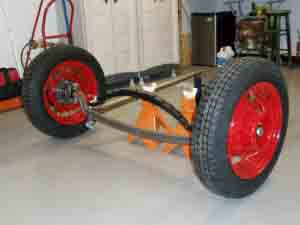
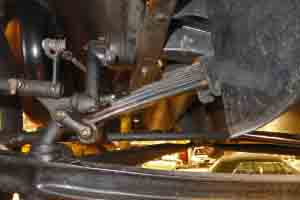
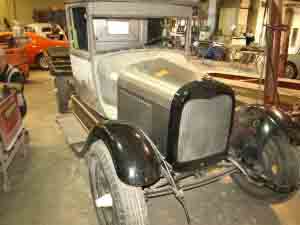
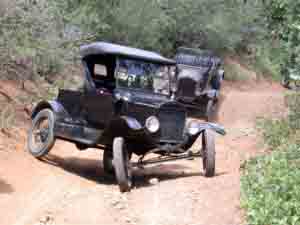
With great thought to price as well as ride comfort most manufacturers used leaf type springs for their suspension. With the release of the Model T in 1908 the world saw one of the first innovations of automobile suspensions from Ford. To save weight and maintain the ride he expected, Ford used only one spring per axle and mounted them transversely. This design became very popular with many manufacturers although it was sometime later before shock absorbers would become important. With the “Runabout” Alanson Brush incorporated the shock absorber with the coil spring, much like a suspension that another man named McPherson is associated with. Alanson had worked with Oldsmobile and Cadillac before leaving to form his own car company in 1904, during this time he tried several different designs of his own and not until his brother wrecked his recently completed “Alanson Crestmobile” did he realize how important the shock absorber was to improved handling for the driver. While Brush motors enjoyed some relative success Alanson’s financial backer had other interests, absorbed by the U.S. Motor company in 1910 the “Runabout” disappeared in 1912 with the collapse of the company.
Shock Absorbers
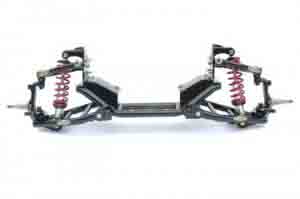
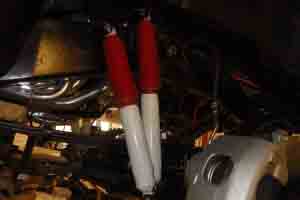
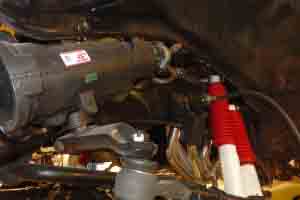
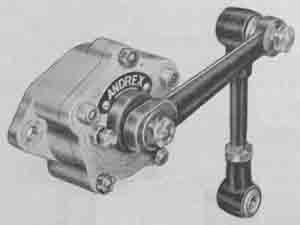
What sets the Brush automobile apart is the use of a hydraulic shock with a coil spring front suspension. There had been other types of shock absorbers, in 1897 A. Gimming used a rubber block just like what we see on many cars now, although the importance of this type of mount now is not the same as it was when introduced. Shocks are all about controlling the suspension and its rebound. A spring absorbs energy and releases energy, when going over a bump the spring absorbs the energy and then releases it by pushing back with equal or greater force. Obviously without some sort of damper this cycle will continue and the vehicle will continue to bounce after hitting a bump, a shock absorber does exactly that, absorbs some of the energy from the spring and controls the release of the energy as well.
Straight/solid Axle front suspensi0n

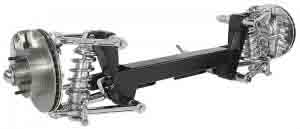
There are two primary types of front suspension and several variants of each. The most widely used on early vehicles was a straight axle, typically supported by leaf springs, either one or two, to support the vehicle, cargo and passenger weight. These were very simple, straight forward suspensions that were rugged but really provided little ride control, even if the customers weren’t aware of it at the time.
King Pins of the automotive world
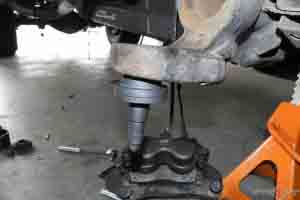
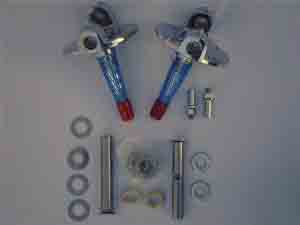
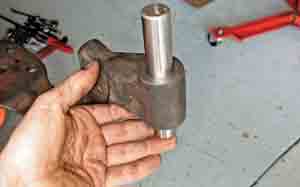
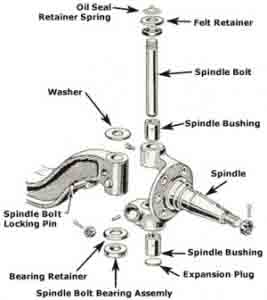
Straight axles use a king pin or a ball joint to attach the spindle and u-bolts to attach the springs, springs were mounted in much the same fashion as today’s leaf spring vehicles, with pivots or slides that allow the spring to work as the overall length of the spring changes while the vehicle travels. Leaf springs are popular even today due to their load carrying ability and the simplicity in which they work. This type of suspension is still used today, particularly on heavy vehicles, you can find solid axle front suspensions on nearly every over the road truck. This is also still a very popular set up for hot rods, using axles set up with a “drop” helps a builder lower his ride with little effort and with the use of either a mono leaf or coil springs and shocks can achieve a decent ride, if spring rate is chosen correctly. Another type of spring used in conjunction with a straight axle is a torsion bar, torsion bars absorb the energy through a long rod attached to the axle and the frame, this set up is designed so that the twist in the rod supports the vehicle and the rod then twists during operation to absorb the energy. The biggest difficulty encountered with straight axle suspensions isn’t poor ride quality but actually poor handling. When driving over rough surfaces or imperfections in the road (pot holes), the suspension has a tendency to skip as one side reacting to the roughness begins to create a loss of control on the opposite side of the vehicle. Not being able to isolate the action of one front wheel lead to the adaptation of independent front suspensions.
Independent Front suspension
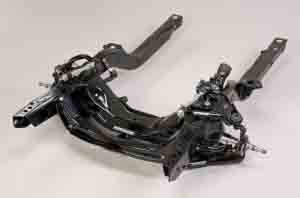
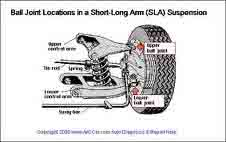
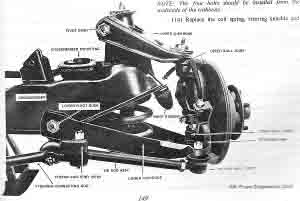
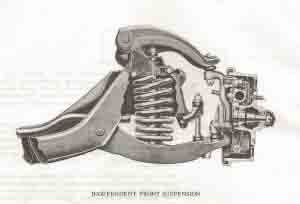
More complex with more moving components independent suspensions greatly improved the handling experienced by those driving a solid axle car. The most common independent front suspension is one using upper and lower control arms to attach the spindle to the car and a coil spring and shock placed between or above the control arms. While many use coil springs there are numerous variants of the design, short arm/long arm systems have unequal length arms that keep the tire perpendicular to the road even over the harshest of bumps.
Torsion bar suspension
Torsion bar style suspensions are also used by many manufacturers with the control arm type suspensions.
McPherson Strut suspension
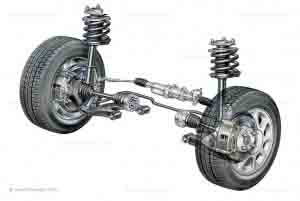
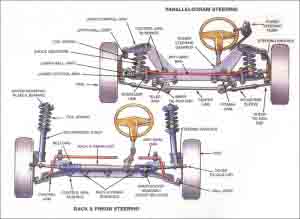
McPherson style front suspensions use a shock absorber and coil spring combination that attaches to the spindle in place of the upper control arm. This system was revolutionary in helping the designers to engineer lower hood lines and add more room for front wheel drive transaxles without sacrificing ride and handling.
Sway bar, Anti-roll bar
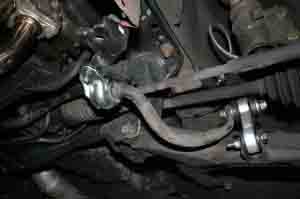

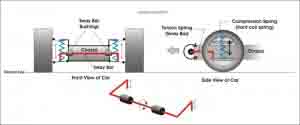
While the springs (leaf, coil or torsion bar) support the vehicle and the shock absorbers control the energy stored and released by the springs, sway bars, or anti-roll bars control the vehicle. Using either a solid bar or a tube, the sway bar is attached to the frame and pivots inside of busings while the ends of the bar are attached, with links, to the lower control arm. Going back to our high school geometry we see how the pressure of the vehicle will cause the sway bar to apply equal force, like a torsion bar, to the opposite side of the vehicle. When getting onto and exit ramp and turning right the body will want to lean left. As the body begins to apply it’s weight the sway bar, or anti-roll bar, transfers the energy and raises the right side of the vehicle to maintain control. Different diameter bars are used based on the application, a heavier, thicker bar will be found on a track vehicle where handling is going to be tantamount to winning the race and passenger cars will have a slightly smaller bar to improve handling without sacrificing ride and drive quality.
Suspension bushings
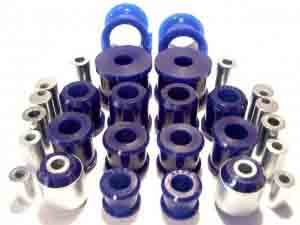
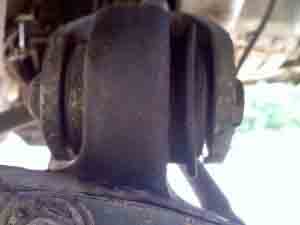
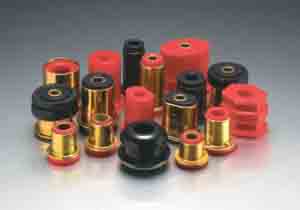
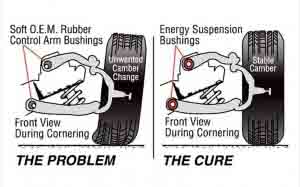
Vehicle suspensions are in constant movement, unless, of course, you’re stopped. Control arms pivot up and down, springs compress and expand, shocks are moving and all of this has to happen in such a way as to provide a better ride, better traction and better handling. Each of these components have to be mounted so they can move freely and still create some isolation between what the suspension is doing and the consumer driving the vehicle. In order to dampen the activity bushings are used in nearly every pivot point of the suspension. The most popular type of bushings are the standard rubber bushings they have used for years which provide for a great ride and a great deal of insulation from the roughness the vehicle may be traversing through at the time. While there are other types, another popular material for bushings is polyurethane. Polyurethane bushings are not as soft as a rubber bushing so more road feel will be transmitted through to the driver, however, being of a more dense material the polyurethane bushings provide for a better handling vehicle and control the changes a vehicle is thrust into easier. Polyurethane bushings, as well as other bushings made of material other than rubber, will typically be found in cars geared more towards performance.
Ball joints
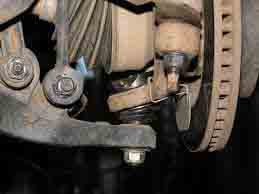
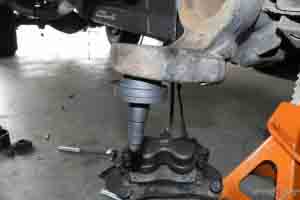


Among all the various components found on a suspension one of the most critical is the common ball joint. Ball joints provide the connection between the vehicle and the tire/wheel. The wheel mounts on a spindle and the spindle is attached to the control arms with this part. For such a small component, built with a ball and socket design, it takes the absolute blunt force of the vehicle. When choosing replacement parts choose a quality piece that is serviceable with grease fittings. The ball joint allows the suspension to pivot up and down while maintaining proper tire angle and also allows the front wheel to turn left or right. This, again, is a very crucial piece of a vehicles front suspension and needs to be inspected, along with the rest of the suspension, for wear or damage regularly, a worn ball joint will lead to, eventually, the spindle coming loose from the control arm creating a loss of control.
As with Ball joints, always choose the best product to meet your needs. Determine how you plan to drive your vehicle and what you plan to use it for and then purchase quality parts, not necessarily the most expensive, but the highest quality. Most of these components are not difficult to service and replace but it isn’t easy work either, don’t waste your time and your money on a product that doesn’t have a good service life. As what some consider hobbyists we may enjoy working on our cars and trucks but mostly it is for improvement, not to re-do work that has already been done.
This is just a basic outline, we are often stuck with whatever suspension system our vehicle has but there are always ways to improve handling, ride and even vehicle stance. Coil springs can be cut to adjust ride height and custom made springs are available so that you don’t have to cut. Leaf springs can be mounted above or under the axle typically to change ride height and leafs can be added or removed based on what you expect from your suspension. Leaf springs can also be re-arched or built custom, based on your preference. Torsion bar type suspensions are the easiest to adjust ride height but, like other types of suspensions, the vehicle requires an alignment to ensure proper handling and to control tire wear. The most important thing to consider is the quality of the components you use. Research what you want to do, research the parts and search related forums online to discover the pitfalls of what you have planned. I also recommend that you keep in mind that anytime you make changes to ride height you also change the geometry of the vehicle and by changing this you are changing how weight is distributed and will affect handling and braking performance, possibly with adverse results. The result you want is a safe vehicle that handles well, rides nice and maybe, with changes in ride height, has a more aggressive stance.
For more information and explore all your options check out our partner Heidts Hot Rod and Muscle Car parts
Another source for quality parts, stock or performance is Jegs




